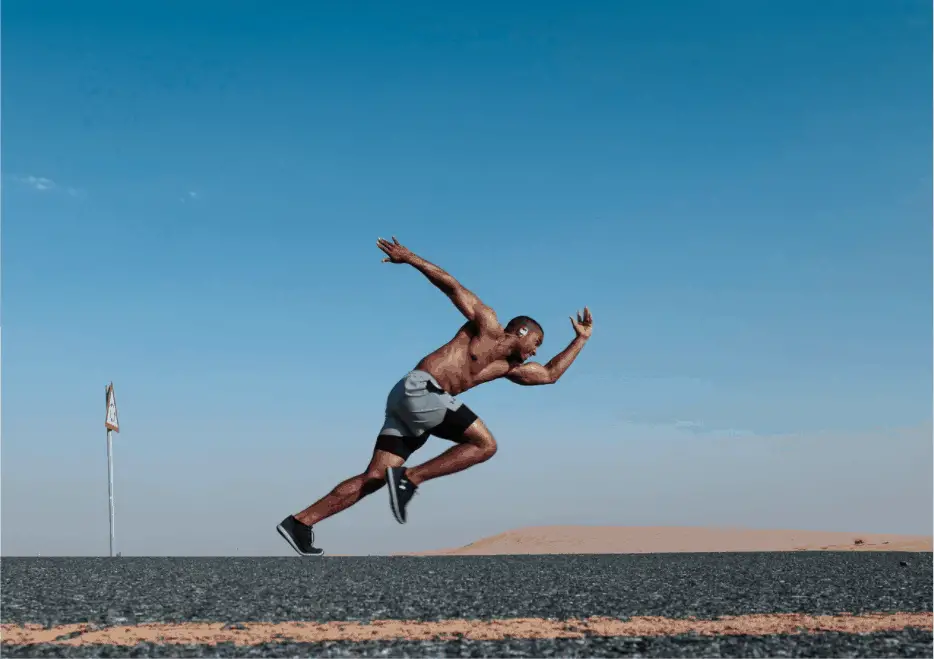This article is evidence-based, verified by Blake Conner, Certified Strength, and Conditioning Specialist.
Cardiovascular activity is a staple in many activities, sports, and careers. Some of which may require it, and with others, it may be highly recommended. You may be interested in getting started with such activities, so we’ll cover a concept that will allow you to improve. Specifically, this article is going to be focused on how to improve your running economy for military and combat sports such as MMA or boxing.
When referring to cardiovascular performance there are two phrases that you may be familiar with.
Lactic acid threshold and VO2 max. These are extremely important when considering cardiovascular and/or running performance. However, one that may not sound as familiar is the running economy.
Table of Contents
What Is Running Economy?
Running economy is described as, “The efficiency at which you can convert oxygen consumption into forwarding motion.”
When performing any aerobic task, we breathe in oxygen. This is then taken into the blood, which is then taken to the heart. From there it is pumped through the body to the working muscle.
The faster we breathe and the more air we take in the more oxygen is pumped through. If we are not efficient at pumping the oxygen through, then it will be much harder for us to propel ourselves forward with whatever activity we are doing. The more cardiovascular activity you do, the more efficient you become, A.K.A. running economy.
An elite runner will be able to tell you how much further they can go with less effort due to their improved efficiency and VO2 Max. One way some athletes artificially boost the latter is through some form of high altitude training or training mask.
This functions sort of like “fuel economy” for a car. The better the economy a car has for driving, the less gas it uses to get a certain distance. Therefore, someone with a really good running economy can perform faster and go farther, all while conserving more energy.
Runners that possess a more efficient running economy use less energy and therefore less oxygen than runners with a poor running economy at the same velocity. This means that even if someone can run the same speed as the competition, they won’t always win. The individual with a poor running economy will fall short and tire out more quickly.
That fatigue can cost you a race, or your PB on Strava.
Besides competitive running, the military and combat sports such as MMA and boxing are settings where running the economy is crucial. Cardiorespiratory activity is in large, an important piece to each one of these. Many individuals currently pursuing these interests must train rigorously, way beyond fatigue if they hope to be successful. Improving their running economy or cardiovascular efficiency can lead them to have more success than someone who does not.

Here are a couple of reasons why it is so important if you are interested in either of these fields:
It can be the difference between winning or losing a match. MMA requires strong cardio endurance and every move matters. If you can outlast an equally skilled individual employing cardiovascular efficiency, you have a high chance of winning. Many combat sport coaches put a massive emphasis on conditioning with their training. An individual can be skilled, but it means nothing if facing an equally skilled opponent who is in better shape.
During a dangerous mission, military personnel are responsible for themselves, but also their fellow man. Having a good running economy may mean saving a life or falling short. If you or anyone you know has been in the military, you know first-hand that cardiovascular activity is taken very seriously. It isn’t uncommon for a service member to run multiple miles in a week.
This is done with the intent to increase conditioning or cardiovascular efficiency. While in the field a military member may be presented with a situation where they need to conserve energy. If they build that running economy for themselves, they will have a better chance of saving as much energy as possible.
What Contributes To A Good Running Economy?
There are multiple contributing factors when considering running economy or cardiovascular efficiency:
Muscle fiber composition
There are two main types of muscle fibers in the human body. TYPE I and TYPE II.
TYPE I typically have lower power output levels but use less oxygen. TYPE II have very high power outputs, but use a lot of oxygen. You can see examples of each in different sports. For TYPE I think of marathon runners, and for TYPE II think of sprinters.
Having more TYPE I muscle fibers creates conditions that are good for long-distance runs. However, it also lowers the potential to produce force. Many marathon runners may be able to run for miles and miles; however, they are typically not as strong.
An individual with more TYPE II muscle fibers will typically be able to lift heavy weights or move heavy objects very quickly. When it comes to cardiovascular activities, they tend to lack. They can perform for short bursts but need to rest in between. An Olympic weightlifter is a great example of a predominately TYPE II athlete. It is not often that they are seen running.
- DEEP MUSCLE RELAXATION - CRYOTEX Massage Gun can deeply relieve the body's soreness through deep and powerful muscle massage after exercise. Handheld Massage Gun for Athletes helps restore the body faster, promote muscle repair, promote blood flow and relieve lactic acid. It can also be used to prepare the body during warm-up before exercise.
- 6 MASSAGE HEADS & 20 LEVELS OF INTENSITY – Comes with six different heads to provide targeted treatment for every muscle group. Different massage heads and speed levels provide a relaxing massage for every muscle need. It reduces bone and muscle damage that might occur in one-level intensity massage guns used for sensitive muscles. Our percussion massager equipped with LCD touch screen showing speed levels.
- LIGHTWEIGHT & CARRYING CASE INCLUDED - Only 2 lbs, ergonomic and easy-to-use. Its compact size and case makes it easy to carry to use at work / gym and while traveling.
A military or combat sports athlete will need a combination of both – especially through strength training. They are required to perform for elongated periods; however, they still need a great deal of power output. Typically, a combination of resistance training and cardiovascular training works very well for both groups.
Genetics play a big role in determining the ratio of TYPE I and TYPE II fibers that an individual possesses. Through different training modalities that are targeted at the desired fiber type, an individual can produce more or less of either fiber type. There is however a threshold barred by genetics, and some individuals will still be majority TYPE I or TYPE II.
Joint Flexibility
Stiffness in muscles is good for activities such as running. There are more serious situations where this could cause injury, but for the most part, stiff muscles produce more force. You don’t see many yoga instructors running 100m sprints at crazy speeds. Having more stiffness in the joints can produce more force, but without using as much oxygen. So, when looking to increase running economy, there needs to be a happy medium with flexibility.
Typically, an individual only needs to be flexible enough at the joint to perform the desired task. An MMA fighter has to get into many different positions, so more flexibility will be needed.
Each athlete will require different tools for their sport. In the same way a runner will need more padded shoes with spongy soles, an MMA fighter will need flat shoes with as much grip as possible.
Boxers will only need good flexibility within the shoulders and back to achieve the proper positions for the desired punches. A military service member may only need basic flexibility to perform runs and or field missions.
Body type
This matters for two reasons. One being that a bigger person is less aerodynamic. When you are fighting the wind, the resistance created by a larger object is going to take more oxygen and energy to propel forward. The second is that it takes less to move the limbs. Very rarely do you see large humans having extremely high fuel economy (yes there are outliers).
As the body grows, the heart has more ground to cover when pumping oxygenated blood. When trying to be as efficient as possible, this can be difficult for someone of a larger size. Many bodybuilders are massive and covered with muscle, however, they get out of breath after running a mile. Their heart just has to work harder.

If someone is smaller or has less tissue to fuel, then the heart has an easier time getting the blood where it needs to go.
If long duration activity is what you are trying to achieve, then losing weight or body fat may help.
Resistance
In a perfect world, you would be able to run freely without anything pushing against you. However, if you have something in your way while running… it’s going to be more difficult. This is going to require more effort and more oxygen. Resistance can come in the form of natural factors such as wind or rain, terrain, or body weight.
Often you will see high performing, cardiovascular athletes wearing little amounts of clothing. They may even shave their legs! This is so that there is less resistance against them as they compete. They are trying to be as efficient as possible concerning their cardiovascular output.
As far as the terrain goes, if an individual is attempting to go uphill this will require more effort. More effort to move muscle, means more oxygen being pumped, which means more energy is expended. This will decrease the running economy during the activity, but it can be used as a tool to increase the running economy.
You can find out more about running economy in a biomechanics lecture at Middlesex University.
Technique
Ensuring you have the right technique for a run means looking at a number of factors.
- Ground contact
- Stride length
- Running speed
- Contact time
- Running form
How long your feet spend touching the floor can make a difference in your efficiency. If your strides are more vertical than horizton (often seen in recreational runners) then there’s plenty of room to improve your running economy.
Additionally, looking at your stride length, or cadence will tell you a lot about your style of running. Whether you take very short steps or really long strides can make a difference on your ability to run further with less input.
To find the best running technique for you, you’ll benefit from visiting a specialist. You’ll be the next Paula Radcliffe in no time!
How You Can Improve Your Running Economy
- Goggins, David (Author)
- English (Publication Language)
- 364 Pages - 03/10/2020 (Publication Date) - Lioncrest Publishing (Publisher)
The FIRST thing you need if you’re looking to improve your running economy is David Goggin’s book. This will give you more motivation than anything else you do. Strength training, pushing your VO2 max, testing your running speed, or even stride length. Goggin’s story is incredible and has changed the lives on many.
One method is resistance training. This can be done by using free weights or machines. Regardless, strength training benefits running economy in many ways.
It can increase the amount of TYPE II muscle fibers in the body, which as stated previously can result in more power and less oxygen consumption. If an individual can stride a farther distance but uses the same amount of energy then they have increased their cardiovascular efficiency.
In the process, gaining muscle mass from resistance training can cause weight loss in the form of body fat. The more skeletal muscle that you have, the more calories you burn. More calories burned leads to weight loss. This then can lead to a smaller and lighter body. As stated previously, this will ultimately create a better running economy by decreasing the resistance and lowering the energy needed to move.
Through resistance training, you also create more resilient bones and joints. The stimulus this kind of training provides causes the bones to get harder, and the joints to adapt. The stress leads to positive adaptations in the structure. This helps to absorb the force from running or any other strenuous activity such as mixed martial arts. The outcome is a decrease in the risk of injury.
The less you are injured, the more you can train. The more you can train, the more efficient you can become. Most individuals aren’t successful because they were better, but because they had fewer setbacks due to injury.
Overall resistance training will create a more efficient body for performance, thus leading to an improved running economy (Source).
Besides, to improve your running economy you can simply run more. This concept may sound obvious but running more often forces you to improve. The better you get at running, the more efficient you become overall. The body will adapt because the strain is hard at first. Ultimately the human body fights to keep a homeostatic state, so constantly driving the volume of running up will cause the proper adaptations.
The last way of making improvements is to get a coach. A coach can help critique your form. Your running economy or cardiovascular efficiency may be low just because you are inefficient with your movement or motor patterns. Just by making a few adjustments, you can create huge improvements in running economy.
If an individual is training for a race, the military, MMA, or boxing a coach will make a substantial difference. Having a professional break your movement down that you don’t notice, will lead to more efficiency.
What to eat to improve your running economy
Consider putting strength training and VO2 max to one side. Have you considered what your diet looks like?
Do you eat McDonald’s every day or are you a full-blown pescatarian? You should look at the fuel you put into your body in addition to all the training you do.
Junk food can be tempting, but if you need to lose a few pounds in order to give your heart a fighters chance to pushing you through the last few miles with the same cadence, then consider a dedicated cutting plan to get you there.
Example Resistance Training Workout For Increased Running Economy
- Barbell Back Squat: 6 sets of 3 reps with a moderately heavyweight
- Dumbbell Reverse Lunge: 3 sets of 10 reps each leg
- Box Jumps: 6 sets of 3 reps
- Barbell Romanian Deadlifts: 5 sets of 10 reps with lightweight, slow on the way down, fast on the way up
A workout similar to this will help to increase overall muscle mass, especially in the legs. By improving the force production of the muscle, increasing TYPE II muscle fibers, and creating stiffness in the muscles and joints; the running economy will increase.
Become Efficient. Become A Savage.
Running economy and running technique is a very important concept. Whether you are working on running or using it as a tool for getting into the military or combat sports, it is extremely useful. It can be improved upon in many different ways, some are small adjustments and others are more difficult to accomplish.
Some individuals may have to play off of their strengths or weaknesses depending on their goals. For example, someone may be genetically predisposed to being more of a TYPE I muscle fiber athlete. They are going to be efficient at cardiovascular activity but have poor strength and power output. Knowing these strengths and weaknesses, work can be done to improve in certain areas.
Introduce some resistance training if you are looking to make some improvements to running economy. Many runners take this advice, and significantly improve their performance. It all comes down to your goals and what you are trying to accomplish.



